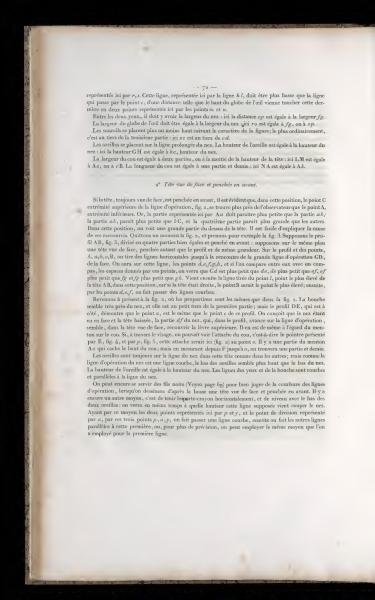... 73 ...
... represented here by r,s. This line, represented here by the line h,l, must be lower than the line that passes through point o, at a distance such that the top of the globe of the eye comes to touch the latter in two points represented here by the points m and n.
Between the two eyes, there must be the width of the nose: here the distance op is equal to the width f,g.
The width of the globe of the eye must be equal to the width of the nose: here op is equal to f g only to oa p.
The eyebrows are placed more or less high depending on the character of the figure; most commonly, it is one-third of the third part: here cz is at one-third of c d.
The ears are placed on the extended line of the nose. The height of the ear is equal to the height of the nose: here height GH is equal to bc, the height of the nose.
The width of the neck is equal to two parts, or half the height of the head: here L M is equal to A C, or to C B. The length of the neck is equal to one and a half parts: here N A is equal to A h.
Head seen from the front and tilted forward.
If the head, always seen from the front, is tilted forward, it is evident that, in this position, point C, the upper end of the operation line, fig. 3, is closer to the observer than point A, the lower end. Thus, the part represented here by Aa should appear smaller than part ab; part a b appears smaller than b c, and the fourth part seems larger than the others.
In this position, a large part of the top of the head is visible. It is easy to explain the cause of these foreshortenings. Let's leave fig. 3 for a moment and take fig. 3 for example. Assume the profile AB, fig. 3, divided into four equal parts and tilted forward: suppose on the same plane a head seen from the front, tilted as much as the profile and of the same size. On the profile and the points A, a,b,c,D, draw horizontal lines until they meet the main line of operation GD, of the face. On this line, the points a,b,c,d; and if one compares with compasses, the spaces given by these points, one will see that CF is smaller than de, de smaller than ef, and ef smaller than fg, fg smaller than fh. Then comes the line drawn from point 1, 2 higher points of the head AB, in this position, because if the head were upright, point B would be the highest point; then, through the points def, curving lines are drawn.
Returning now to fig., 3, where the proportions are the same as in fig. t. The mouth seems very close to the nose, and it is at the small third of the first part; but the profile DE, which is on the side, the same as point a, is the same as point c of this profile, where as point c is facing and the head is lowered, part d of the nose, which, in profile, will move forward on the operation line, seems, in the face view, to cover the upper lip. It is the same with the chin on the neck. If through the face, one found that to see the neck attachment, that is to say, the point presented by E, fig. 4; and by p, fig. 5, this attachment would be here (fig. 3) at point a. there will be a portion of the çou who with the top of the neck; but by measuring from F to a, one will find a drawn part.
The ears are always on the nose line in this head as in the others; but as the operation line of the nose is a curved line, the bottom of the ears seems higher than the bottom of the nose. The height of the ear is equal to the height of the nose. The lines of the eyes and the mouth are curved and parallel to the nose line.
One can again use black threads (See page 69) to better judge the curvature of the operation lines, when drawing from the bump a head seen from the front and tilted forward. There is still another way, it is to hold the crayon holder horizontally, and level with the bottom of the two ears: one will see at the same time at what height this supposed line comes to cut the nose. Having by this means the two points represented here by p and y, and the division point represented by a, through these three points p, a, q’, a curved line is drawn, then the other lines parallel to this first one are made, or, for more precision, one can use the same method as was used for the first line.
The text describes the proportions and positioning of facial features when viewed from the front and tilted forward. Key aspects discussed include the distances and sizes of the eyes, nose, and ears relative to each other, with guidelines for accurately portraying these elements. Methods for judging line curvatures when drawing a head positioned this way are also detailed.
